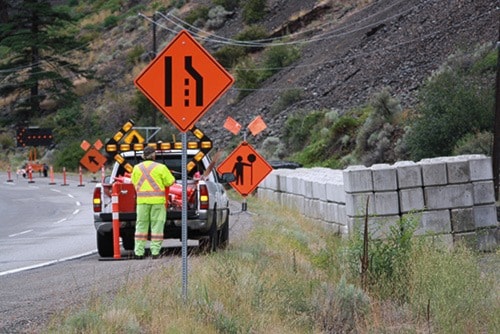Eight months after a major rock slide temporarily closed Highway 3 between Hedley and Keremeos, work to construct a concrete barrier at the slide area is scheduled to begin in September.
In response to recent inquiries by the Review to the Ministry of Transportation and Infrastructure, a media spokesperson said Monday that a long term safety improvement plan was being formulated to prevent rockfall from reaching the highway, in addition to eventually restoring the road to four lanes.
Information released through Freedom of Information requests by the Keremeos Review and Penticton Western also chronicled the history of rockfalls in the slide area, in addition to the ministry’s risk assessment of the slide zone.
In the days following the January 27, 2014 rockslide nine kilometres west of Keremeos, highway officials anticipated the earthen berm placed in the highway’s westbound slow lane would remain in place at least until a warm weather event occurred.
An email sent on January 30, 2014, by Jeff Wiseman, Penticton Operations Manager for the Ministry of Transportation and Infrastructure, to Argo Road Maintenance outlined the traffic protocols to be initiated prior to the highway opening that evening after being closed for four days due to the original rockslide.
Originally, the criteria outlined for keeping the highway open involved the the establishment of a light plant to supply lighting to the area, in addition to flaggers and a spotter who would “close monitor” the slide area.
In the case of a rockfall event of up to two cubic metres, all traffic through the area would be stopped and the area monitored for further events for 30 minutes. If no more rock fell, the highway would reopen.
If more than two cubic metres fell, all traffic would be stopped and the highway closed until a geotechnical assessment could be carried out.
If no activity was reported during the first weekend following the Friday evening opening, an enhanced patrol, consisting of a patrol once every four hours. The light plants and a loader would remain in place to remove any rockfall material.
The ministry then waited for a warm cycle to occur, anticpating if the slope remained stable, a normal patrol of the road (once every 24 hours) would be reinstated.
“Once a warm weather event has occurred and the slope remains inactive for rock fall, the ministry will then advise Argo that the protective berm can be removed and work can begin to restore the highway to its previous four lane capacity, repairing all damage caused by the rock fall incident at that time,” the email concluded. Subsequent rock slides quickly negated those plans, however.
On February 19, March 5 and again on April 16, minor rock slides occurred at the site. No other significant events occurred at the slide area until the evening of May 4, when, during a heavy rainfall, a couple of boulders tumbled down the mountainside, damaging a tractor trailer. Another rockslide occurred on Friday, June 13 again following heavy rains, this time damaging two more vehicles.
An engineering report, issued in April, described the slide area as one of “low frequency, high volume rock fall events which have had high consequences.” It noted that prior to the January 27, 2014 incident, a slide on December 6, 2003 totalling four cubic metres also damaged four vehicles.
“A total of eight recorded rock fall events have occurred with potentially serious consequences,” the report said, adding since the January 27, 2014 event there has been an increase in rock fall activity in this area. It also noted the rock was originating from 400 to 500 metres above the highway.
The ministry told the Review in late May “The temporary berm has been successful at reducing rock fall on the road. The ministry’s geotechnical engineers are reviewing whether or not further modifications at this site are required while observing the site through the spring thaw.
“Until that assessment is completed, we will leave the temporary berm in place and continue our monitoring process.”
Eight months later, the earthen berm remains while the ministry finalizes plans to complete long term safety improvements to the slide area in two phases:
- Phase one involve the construction of a three metre high concrete wall in the westbound slow lane where the earthen berm now sits. The work is expected to begin in mid-September.
-Phase two involves the excavation of the upper slope to create a wider ditch, a large rock catchment area and to re-establish the highway to four lanes.
The ministry looked at several potential options before selecting the two phased approach above.
“Public safety is the ministry’s top priority,” said the ministry in its communication. “A number of steps are necessary before long term safety improvements are made at this location. including such things as a geotechnical assessment, engineering design work, and materials acquisition.”
The communication did not say how long the project would take to fully complete.
